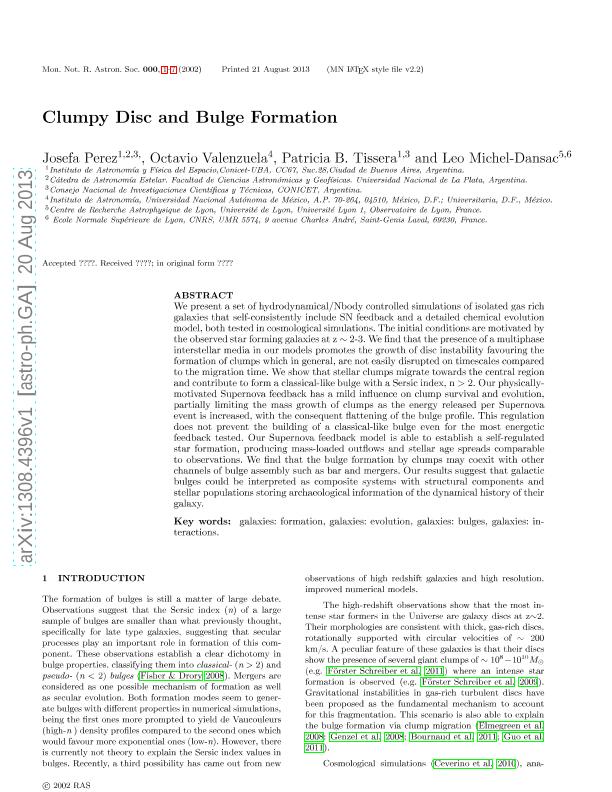Artículo
Clumpy disc and bulge formation
Perez, Maria Josefa ; Valenzuela, Octavio; Tissera, Patricia Beatriz
; Valenzuela, Octavio; Tissera, Patricia Beatriz ; Michel-Dansac, Leopold Laurent Joseph
; Michel-Dansac, Leopold Laurent Joseph
 ; Valenzuela, Octavio; Tissera, Patricia Beatriz
; Valenzuela, Octavio; Tissera, Patricia Beatriz ; Michel-Dansac, Leopold Laurent Joseph
; Michel-Dansac, Leopold Laurent Joseph
Fecha de publicación:
11/2013
Editorial:
Wiley-blackwell Publishing, Inc
Revista:
Monthly Notices Of The Royal Astronomical Society
ISSN:
0035-8711
Idioma:
Inglés
Tipo de recurso:
Artículo publicado
Clasificación temática:
Resumen
We present a set of hydrodynamical/N-body controlled simulations of
isolated gas-rich galaxies that self-consistently include supernova (SN)
feedback and a detailed chemical evolution model, both tested in
cosmological simulations. The initial conditions are motivated by the
observed star-forming galaxies at z ? 2-3. We find that the
presence of a multiphase interstellar media in our models promotes the
growth of disc instability favouring the formation of clumps which, in
general, are not easily disrupted on time-scales compared to the
migration time. We show that stellar clumps migrate towards the central
region and contribute to form a classical-like bulge with a
Sérsic index, n > 2. Our physically motivated SN feedback has
a mild influence on clump survival and evolution, partially limiting the
mass growth of clumps as the energy released per SN event is increased,
with the consequent flattening of the bulge profile. This regulation
does not prevent the building of a classical-like bulge even for the
most energetic feedback tested. Our SN feedback model is able to
establish self-regulated star formation, producing mass-loaded outflows
and stellar age spreads comparable to observations. We find that the
bulge formation by clumps may coexist with other channels of bulge
assembly such as bars and mergers. Our results suggest that galactic
bulges could be interpreted as composite systems with structural
components and stellar populations storing archaeological information of
the dynamical history of their galaxy.
Palabras clave:
Galaxies: Bulges
,
Galaxies: Evolution
Archivos asociados
Licencia
Identificadores
Colecciones
Articulos(IAFE)
Articulos de INST.DE ASTRONOMIA Y FISICA DEL ESPACIO(I)
Articulos de INST.DE ASTRONOMIA Y FISICA DEL ESPACIO(I)
Citación
Perez, Maria Josefa; Valenzuela, Octavio; Tissera, Patricia Beatriz; Michel-Dansac, Leopold Laurent Joseph; Clumpy disc and bulge formation; Wiley-blackwell Publishing, Inc; Monthly Notices Of The Royal Astronomical Society; 436; 11-2013; 259-265
Compartir



